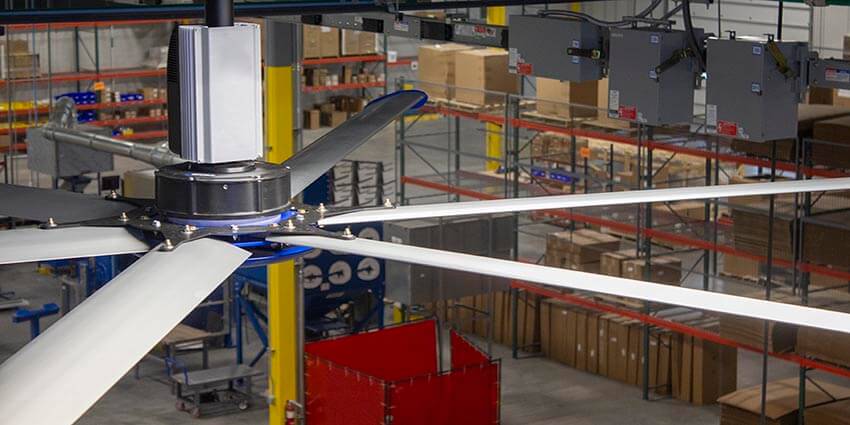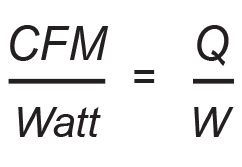
High volume, low speed (HVLS) fans are large diameter ceiling fans that have gained significant popularity in the HVAC industry over the last several years. Like your ceiling fan at home, HVLS fans are a great way to circulate air and make the places that we live and work more comfortable. But, unlike their residential cousins, HVLS fans are designed to move massive amounts of air by taking advantage of much larger fan sizes that range up to 24 feet in diameter! How does a manufacturer measure the performance of these fans? Why is it important? Let’s look at how HVLS performance is commonly measured and the performance information to consider when purchasing an HVLS fan.
How are HVLS Fans Tested?
As you might expect, testing the performance of a 24-foot diameter (D) ceiling fan can be challenging. Fan manufacturers rely on a variety of third-party industry organizations who develop test standards
to simplify the process. One such organization is the Air Movement and Control Association International (AMCA). AMCA is a not-for-profit association that develops standards, certifies products, and educates the marketplace about air movement
and control.
 |
| Figure 1 - Test Setup for Ceiling Mounted Circulation Fans |
Since 1999, AMCA has developed and refined a test standard for HVLS fans and other circulation products currently known as AMCA 230-15. This standard establishes the test methodology and calculations required to determine airflow and efficiency. According to the standard, HVLS fans must be tested by hanging the fan from a load cell inside a large, open space where the fan is a minimum distance from the ceiling, floor, and walls (Fig. 1) to ensure accurate, consistent performance measurement. During testing, the load cell measures upward thrust force created by the fan to calculate airflow with the following equation.
 |
Where:
Q = Airflow rate in terms of cubic feet per minute (CFM)
A = Circular area of the fan in terms of square feet (ft2)
F = Thrust force generated by the fan in terms of pounds (lbs)
ρSTD = Standard air density, 0.075 lbm/ft3
In addition to thrust, AMCA 230-15 also requires manufacturers to measure and record the electrical input power (watts) used by the fan during each test by using an electric meter. This energy consumption data is then used to calculate the efficiency of an HVLS fan by determining the amount of air a fan can move per watt of electrical energy consumed (CFM/Watt) as shown.
 |
Where:
Q = Airflow rate in terms of cubic feet per minute (CFM)
W = Electrical input power in terms of watts
While this test procedure is relatively simple, completing performance testing for a single HVLS fan model can be a long and complex process. It requires carefully calibrated equipment, multiple tests at various operating speeds, and the collection of thousands of data points during each test. To ensure that this data is collected and published accurately, AMCA offers third-party verification of a manufacturer’s tested data through the AMCA Certified Ratings Program (CRP). Under the CRP, manufacturers can submit their tested performance data to AMCA along with a representative fan sample for verification testing at AMCA’s test facilities. AMCA staff will test the product and compare the resulting data to the manufacturer’s submitted data to determine its accuracy. If the two sets of performance data match, AMCA will certify that the HVLS fan performs as published and allow the manufacturer to place the AMCA seal on their products for easy identification. This type of certification is a guarantee that an HVLS fan will perform as specified, making it easy for HVLS fan customers to identify a trustworthy product.
Why Testing is Important
Accurate performance data is important for a variety of reasons. The most obvious is that it allows customers to know they have a product that works as advertised. Beyond that, accurate information also is critical to determine the right HVLS fan for each application. Customers can easily choose the wrong fan size for their space or make the mistake of ordering too many or too few fans for the airflow they need without reliable data. For this reason, HVLS fan customers should always request performance data from a manufacturer and confirm that fan performance is certified by AMCA. Otherwise, customers have no guarantee that their HVLS fans deliver the required airflow.
Other Performance Considerations
Airflow and efficiency are two of the most critical performance characteristics for an HVLS fan. However, these aren’t the only measurements to consider. In particular, HVLS customers should also pay attention to a fan’s sound levels and the air speed at floor level. Unfortunately, no universal test standards currently exist for collecting this type of data, so test methods vary by manufacturer. While most HVLS manufacturers employ good laboratory testing practices to obtain this information, it is extremely important that HVLS customers compare the test methods used by each manufacturer. In the near term, this is the only way to ensure fair and accurate product comparisons when making a buying decision. However, the American Society of Heating, Refrigerating and Air-Conditioning Engineers (ASHRAE) is developing an HVLS air velocity test standard known as Standard 216P that is intended for publication soon. AMCA has also begun gathering information and proposals on a sound testing standard for circulation fan products, but this will likely require several years of development before it is widely available. These two standards will allow for more consistent testing and improve the data that is available to HVLS customers in the future.
Considering HVLS fans? Read this free application article to learn more.


from